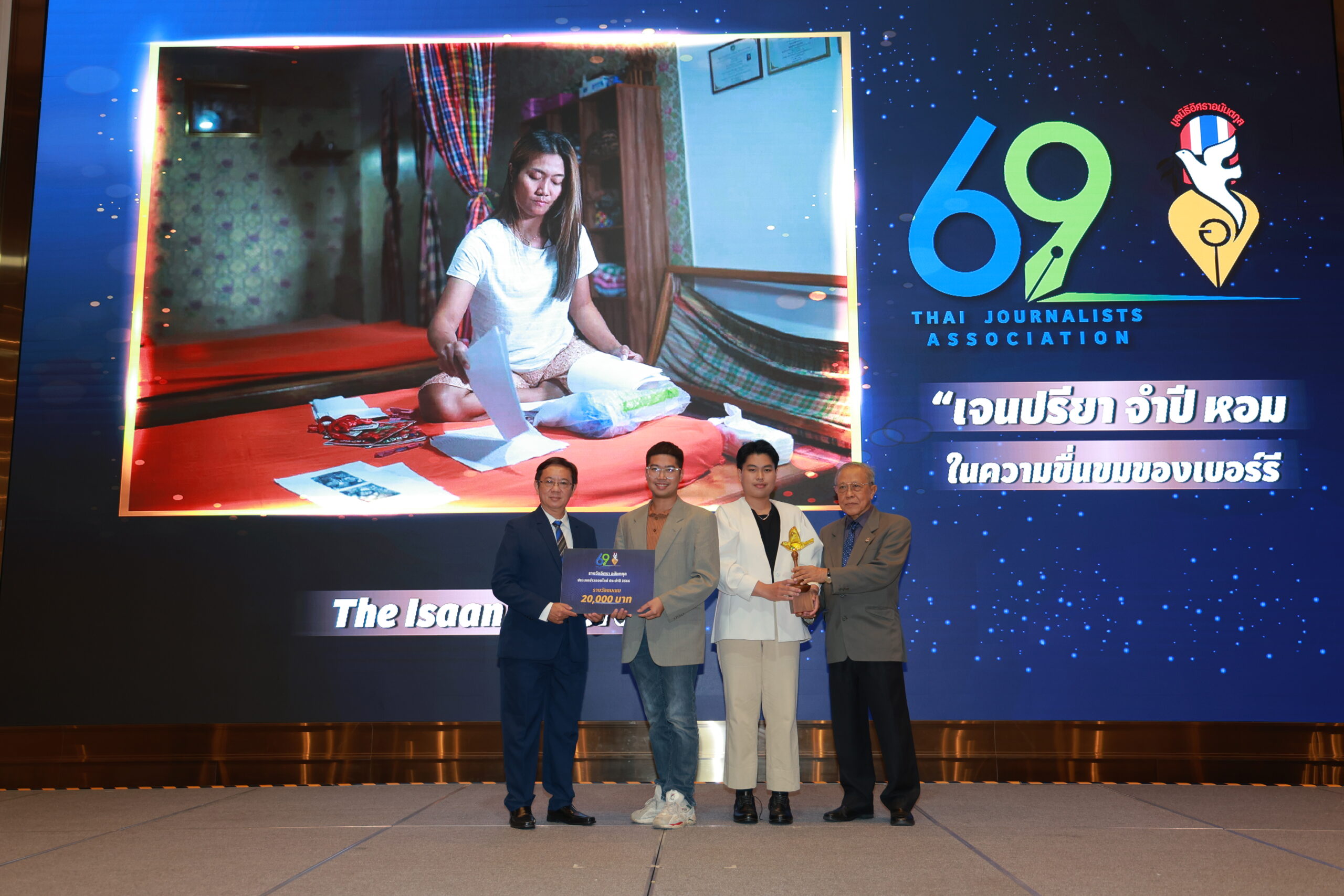KHON KAEN – The rough sea, rolling dunes and tightly packed bales of hay of Northern Denmark seem to have little in common with the Northeast of Thailand. At opposite sides of the world, the two regions are yet intimately connected. A wave of marriage migration from Isaan to the sparsely populated district of Thy in northwestern Jutland began with one woman from Khorat in 1992. In a little more than two and a half decades later, the district is now home to over 900 Thai women and their Danish husbands.
A remarkable new documentary filmed over ten years follows the lives of a pioneer migrant woman and the Thai-Danish couples she brought together as a matchmaker. “Heartbound – A Different Kind of Love Story” by Sine Plambech and Janus Metz had its Thailand premiere in Khon Kaen last month as part of the Khonkaen Manifesto Art Festival.
Drawing a crowd of over 100 people, the screening was followed by discussion on marriage migration, gender, and stereotypes of the mia farang (white foreigners’ wife) in Thai society.

The screening of “Heartbound – A Different Kind of Love Story” and a discussion on migration and gender was organized on 23 October, 2018, sponsored by The Isaan Record with support from Heinrich Böll Foundation.
Isaan women in the global intimate
All over the world, migration has grown rapidly over the last quarter-century. The fate of refugees and migrants has been grabbing global news for years, sparking heated discussions about how immigration is reshaping western societies. But at the same time, the rising migration trend of Thai women, especially from the Northeast, to Western Europe, Australia and the U.S. in the past 15 years, has gone largely unnoticed.
In European countries, like Denmark, Sweden, and others, statistical data show that Thai women have become the most popular choice of foreign partners for men. In Denmark, the number of Thai immigrants has risen markedly since the 1980s. From 2008 to 2017, there has been a 65 percent increase of adult female immigrants. In the country of 5.8 million people, there are 12,625 Thais, most of them, 83 percent, are women.
Driven by national and global inequalities, Isaan women have been at the forefront of this trend that has become more visible since the 2000s. “They go because of the inefficiency of the Thai state to distribute resources and wealth evenly to the population,” explained Sirijit Sunanta, a migration expert from Mahidol University, at the event in Khon Kaen.

The state’s failure to distribute wealth evenly among the population drives Isaan women to seek their luck abroad, often through marriage migration. Marrying a foreigner enables women to overcome their disadvantaged economic status said Sirijit Sunanta, assistant professor at the Research Institute for Languages and Cultures of Asia at Mahidol University.
“Some groups of women are forced to find other ways to overcome the obstacles they and their families are facing,” she said, adding that Isaan women who marry foreigners tend to come from economically disadvantaged backgrounds.
Despite the western stereotype of the young, naive “Asian bride,” the majority of Isaan women enter transnational marriages when they are in their late twenties or older. They often have children from an earlier partnership with Thai men.
Although there is no recent data, a 2004 government study found more than 15,000 women from the Northeast had married or were dating foreign men and supported their families with a monthly total of 122 million baht (about $3.69 million), an average of $2,880 a year–s significant amount given that Thailand’s GDP in 2004 was $2,676.
Desires and expectations
Thai marriage migration is seen as a legacy of the Cold War and Thailand’s popularity as an exotic-erotic tourism destination. In the coastal tourist centers of Pattaya and Phuket, Isaan women make up a large share of the service workers in night-entertainment venues.
But in contrast to common perception, most Isaan women are not driven to tourist spots to find employment in the sex industry anymore, according to Patcharin Lapanun of Khon Kaen University who studies transnational marriages in the Northeast.
“Studies of transnational marriages of Isaan women since 2000 have shown that they don’t go to Pattaya to engage in sex work like in the past,” Ms. Patcharin said. “They go to meet tourists, hoping to marry and spend their lives with a foreigner.”

Isaan women are expected to be grateful daughters who take care of their families but the same is not expected of men, noted Patcharin Lapanun, a lecturer at the Department of Sociology and Anthropology, Faculty of Humanities and Social Sciences, Khon Kaen University.
In the documentary “Heartbound,” pioneer migrant woman Sommai visits one of her protégés who had just taken a job in a tourist bar in Pattaya hoping to find a foreign husband. “What else can you do when you have no money?” she tells the young Isaan woman. “If you work in the fields, you won’t meet any foreigners.”
Ms. Patcharin has observed a shift from Isaan women’s short-term sexual involvements with foreigners to long-term relationships which can enable the women to improve the economic standing of their families.
But she stresses that there are multiple factors for Isaan women to choose to marry a foreigner. “Often people think, if it’s not a love marriage; it must be because of financial reasons,” Ms. Patcharin said. “But in reality there always many different factors involved.”
Isaan women’s aspirations for a better life through marriage and migration are often closely linked to societal and family responsibilities. For Ms. Patcharin this reflects a gap in gender role expectations in Isaan society.
“Some people believe daughters must show gratefulness by taking care of their parents,” Ms. Patcharin noted. “This raises the question why women need to be grateful children to their parents but men don’t have to take on this role.”
Similar dynamics are at play for the majority of Thai women working in the sex industry, said Thanta Laovilawanyakul of the EMPOWER Foundation, an organization that has been promoting sex workers’ rights since the 1980s
“They would do anything for their families and loved ones,” Ms. Thanta said. “That’s why many women choose this occupation because it provides the income to improve their lives.”
Having worked with women employed in Thailand’s sex industry for more than 20 years, Ms. Thanta found that most of them work to provide for their children and to take care of their parents. Their ultimate goal is to raise the social and economic status of their families, Ms. Thanta said.

Thanta Laovilawanyakul of the EMPOWER Foundation argued that outdated gender role expectations in Thai society are an obstacle to efforts to strengthen the rights of sex workers. She called for the abolishment of the 1996 Prevention and Suppression of Prostitution Act and to legalize sex work (film still from “Heartbound”).
Mia farang and materialist rural women
In Thailand, the public debate about female migration has often been overshadowed by a focus on human trafficking and a stigmatization of rural women who marry foreigners.
The state sees Thai female migrants at risk of falling victim to abuse, scams, and trafficking. The state responded with well-intentioned education campaigns for women interested in marrying foreigners and moving abroad.
In August, the Ministry of Social Development and Human Security opened an education center for Isaan mia farang (white foreigners’ wife) in Khon Kaen, oddly calling it a “clinic.” A local government official was quoted saying that the center targets “especially Isaan women and girls who don’t value studying but like to work in bars and massage parlours instead.”
The phenomenon of the mia farang has been invoking rather conflicting opinions in Thai society. In urban middle class circles, transnational marriages and romantic relationships between Isaan women and foreigners are often objects of contempt as the women are seen as immoral materialists. It feeds into a moral panic of rampaging materialism and consumerism which threatens “Thai traditional values,” Ms. Sirijit wrote in a 2013 paper.
But in rural villages, successful marriage migrant women are admired for their cosmopolitanism and their ability to financially support their relatives who stayed behind. The main character in the documentary “Heartbound,” who married a Dane and has been living abroad for 26 years, is celebrated as a hero in her home village in Khorat.
Ms. Patcharin notes that the economic and social effect of transnational marriages in Isaan change society’s class structure. Choosing a foreign husband can not only enable rural Isaan women to raise their economic status but it also gives them access to a cosmopolitan lifestyle.
“The life experiences of these women are different from that of the urban middle class,” Ms Patcharin said. “It’s the birth of a new class that challenges established class structures in Thai society.”





